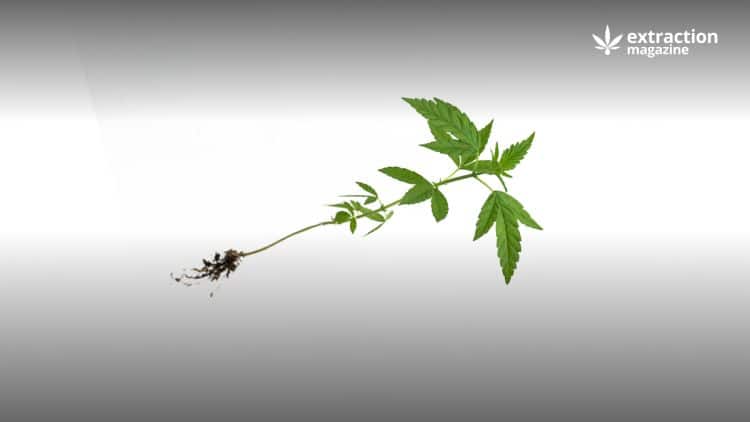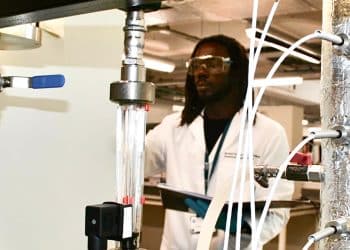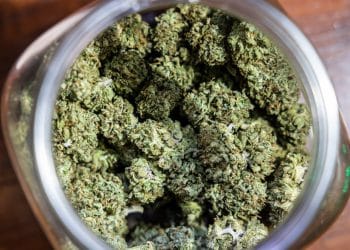Almost every part of the cannabis plant can be utilized beneficially. Aside from the potent buds, the stems can produce fibers and building materials, the seeds can be used in food production, and the leaves hold potential as a green biomass fuel source. [1][2][3][4] Cannabis roots are one of the most overlooked parts of the cannabis plant.
Though they are not a potent source of cannabinoids, cannabis roots hold the potential to treat a variety of medical conditions thanks to the active compounds contained in them. In fact, cannabis roots were first employed medically as a treatment for gout by Pliny the Elder during the Roman Empire. [5]
Since then, herbalists and medical professionals from all over the world use cannabis roots to treat many other maladies. Depending on preparation and administration methods, cannabis roots could potentially provide a new source of cannabis based medicines.
Mixing and Pulverizing Raw Roots
The most rudimentary form of preparation is to use the roots in their raw form. By avoiding any applications of heat or concentration methods, the raw plants allow the medicinal constituents to remain unaltered. These medicinal compounds include triterpenoids, monoterpenes, alkaloids, sterols, and choline in varying amounts. [6][7][8][9][10] Ground cannabis roots provide a cooling sensation, so they can be applied directly onto burns to provide fast relief. [11] The same also works for joint pain caused by inflammation, with dermal application providing relief from the physical pain. [12]
This method often mixes the ground root with a fat or butter to help the application, but it also recommended to combine them with wine to allow oral consumption, to help relieve gastrointestinal distress. [13][14]
Making Juice or Decoction
Like the basic raw materials, cannabis root juice and decoction can relieve consequences of burns, inflammation or gastrointestinal diseases. The advantage of these two preparation methods over basic raw material is that the medical constituents from cannabis roots become more concentrated, allowing for increased dermal and oral absorption.
This increased absorption allows for more treatments to emerge, one of the most significant relating to complications surrounding childbirth. The juice from cannabis roots is common medeicine of Chinese Medicinal practitioners to prevent postpartum hemorrhaging. [15]
When consuming the oral solution, women in childbirth can experience thickening vaginal discharge, which can help to stop excessive bleeding, flooding, or spotting. This thickening not only stops hemorrhaging, but can also help retain the placenta.
Decoction, on the other hand, is more typically applied directly to the troubled area, instead of being absorbed through the stomach. This concentrated form of cannabis roots serves one additional purpose beyond pain relief: vermin removal. [16] This technique was employed by various cultures in different ways.
The Ancient Greeks applied it directly to ears to remove ear worms, and in Burkina Faso it is used intrarectally to remove intestinal parasites.[17] Additionally, an 18th century Persian medical text called Makhzan-al-Adwiya records using cannabis use as a treatment for infections in horses [18].
It is unclear how effective these treatments are compared to synthetic alternatives, but they are often employed as traditional medicinal solutions from around the world.
Why Boiling the Roots?
Boiling the plant roots helps to break down the plant matrix. This helps extract more efficiently the highest concentration of medicinal ingredients. Boiled roots represent the first known medicinal application of cannabis roots by Pliny the Elder to treat gout in Ancient Rome. [19] This practice was authentic for the Roman Empire as far away as for China.
By boiling roots and wrapping any area of physical discomfort, pain relief from joint pain, rheumatism, and arthritis can be achieved. Direct compresses of boiled cannabis roots may also be used to treat “hard tumors,” but the word “tumor” does not necessarily mean cancer the way we think of it today. [20] This terminology stems from the 12th century, and could refer to anything from ulcers, sores, or pulled muscles. [21]
This same source also touted boiled cannabis roots as a treatment for fevers, but that may be tied in with an additional effect. In various Bangladeshi communities, boiled cannabis roots were touted as the treatment for sexually transmitted diseases. [22]
Specifically, these communities used the roots to treat gonorrhea and syphilis, both of which are bacterial infections. This implies that cannabis roots may hold antibacterial properties, but there is no conclusive link.
Additional evidence does exist to support this claim though, as cannabis roots are useful in Argentina and Uganda as treatments for malaria, and it is helpful with treating erysipelas. [13][23][24] Each of these three conditions is bacterial, but the additional evidence may only be a correlation and not a causation.
Additionally, boiled cannabis roots can also be used to induce vomiting when taken orally. [25] This may provide an option to help remove toxins, similar to the vermin removal of juice or decoction. It is interesting to note that this has an opposite effect to other parts of the cannabis plant that have been known to prevent nausea.[26]
Evidence is still developing, but the answer to this may reside in the lack of cannabinoids found in cannabis roots, compared to other parts of the plant. [27]
References:
-
- Deng, Gang, et al. “Planting density and fertilization evidently influence the fiber yield of hemp (Cannabis sativa L.).” Agronomy 9.7 (2019): 368.
- Sorrentino, Giuseppe. “Introduction to emerging industrial applications of cannabis (Cannabis sativa L.).” Rendiconti Lincei. Scienze fisiche e naturali 32.2 (2021): 233-243.
- Iftikhar, Amna, et al. “Applications of Cannabis sativa L. in food and its therapeutic potential: From a prohibited drug to a nutritional supplement.” Molecules 26.24 (2021): 7699.
- Ţîţei, Victor, et al. “Biomass quality of hemp, Cannabis sativa L. and prospects of its use for various energy purposes.” Agronomy 63 (2020): 2.
- Bostock, John, and Henry T. Riley. “Pliny the Elder: The natural history.” Perseus at Tufts (1855).
- Jin, Dan, et al. “Secondary metabolites profiled in cannabis inflorescences, leaves, stem barks, and roots for medicinal purposes.” Scientific Reports 10.1 (2020): 1-14.
- Allen, Keith D., et al. “Genomic characterization of the complete terpene synthase gene family from Cannabis sativa.” PloS one 14.9 (2019): e0222363.
- Radwan, Mohamed M., et al. “Cannabinoids, phenolics, terpenes and alkaloids of cannabis.” Molecules 26.9 (2021): 2774.
- Jin, Dan, et al. “Identification of chemotypic markers in three chemotype categories of Cannabis using secondary metabolites profiled in inflorescences, leaves, stem bark, and roots.” Frontiers in Plant Science 12 (2021): 699530.
- Wahby, Imane, et al. “Analysis of choline and atropine in hairy root cultures of Cannabis sativa L. by capillary electrophoresis‐electrospray mass spectrometry.” Electrophoresis 27.11 (2006): 2208-2215.
- Odieka, Anwuli Endurance, et al. “The medicinal natural products of Cannabis sativa Linn.: A review.” Molecules 27.5 (2022): 1689.
- Hammell, D. C., et al. “Transdermal cannabidiol reduces inflammation and pain‐related behaviours in a rat model of arthritis.” European journal of pain 20.6 (2016): 936-948.
- Manfred, Leo. Siete mil recetas botánicas a base de mil trescientas plantas medicinales. No. 581.634 M35 1979. 1979.
- Elhendawy, Mostafa A., et al. “Chemical and biological studies of Cannabis sativa roots.” Medical cannabis and cannabinoids 1.2 (2019): 104-111.
- Tan, Fang, et al. “Chinese materia medica used in medicinal diets.” Journal of Ethnopharmacology 206 (2017): 40-54.
- Butrica, James L. “The medical use of cannabis among the Greeks and Romans.” Journal of Cannabis Therapeutics 2.2 (2002): 51-70.
- Nadembega, Pascal, et al. “Medicinal plants in Baskoure, Kourittenga province, Burkina Faso: an ethnobotanical study.” Journal of ethnopharmacology 133.2 (2011): 378-395.
- Russo, Ethan. “Cannabis in India: ancient lore and modern medicine.” Cannabinoids as therapeutics (2005): 1-22.
- Aldrich, Michael. “Therapeutic Cannabis.” Cannabis in medical practice: A legal, historical and pharmacological overview of the therapeutic use of marijuana (1997): 35.
- Van Pelt, Blair. “Characterization of Medicinal Properties of Cannabis sativa L. Roots.” (2008).
- Masic, Izet. “Thousand-year anniversary of the historical book:“Kitab al-Qanun fit-Tibb”-The Canon of Medicine, written by Abdullah ibn Sina.” Journal of research in medical sciences: the official journal of Isfahan University of Medical Sciences 17.11 (2012): 993.
- Rahmatullah, Mohammed, et al. “A survey of medicinal plants used by Garo and non-Garo traditional medicinal practitioners in two villages of Tangail district, Bangladesh.” American Eurasian Journal of Sustainable Agriculture 5 (2011): 350-357.
- Tabuti, John RS. “Herbal medicines used in the treatment of malaria in Budiope county, Uganda.” Journal of ethnopharmacology 116.1 (2008): 33-42.
- Rubin, Vera, ed. Cannabis and culture. Walter de Gruyter, 2011.
- Hourfane, Sohaib, et al. “A Comprehensive Review on Cannabis sativa Ethnobotany, Phytochemistry, Molecular Docking and Biological Activities.” Plants 12.6 (2023): 1245.
- Rock, E. M., et al. “Cannabidiol, a non‐psychotropic component of cannabis, attenuates vomiting and nausea‐like behaviour via indirect agonism of 5‐HT1A somatodendritic autoreceptors in the dorsal raphe nucleus.” British journal of pharmacology 165.8 (2012): 2620-2634.
- Parker, Linda A., Erin M. Rock, and Cheryl L. Limebeer. “Regulation of nausea and vomiting by cannabinoids.” British journal of pharmacology 163.7 (2011): 1411-1422.












